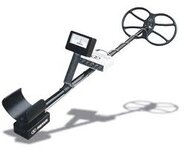It depends on how much battery power is put in individual frequencies of a multi, or in a single. No one says what the actual transmitter power output is in whatever it is measured in of e
ach radio frequency. And the FCC classifies metal detectors as non emitters, so it is low. (A P.I. has 10x to 20x the power of a VLF but it can do this because it is a intermittent transmitter and can still have a "reasonable" battery life. If a VLF could transmit at the same level the battery life would be short because they transmit constantly.) The only thing you can do is personally test some targets in your area and tabulate the results. In wet salt I would think a multi would be deeper. But, in 1972 Technos Inc. in Maitland, Fla. had some NASA engineers get together and make a TR-IB high frequency unit with target i.d. on a meter called a P.R.G. or Phase Readout Gradiometer for hunting the beaches there for Spanish gold coins and it would hit a quarter at 12 inches in light to moderate minerals, and there was not a motion circuit or ground cancel circuit. (George Payne patented motion in 1977.) When the mineral increased though depth decreased, and it would not work it black sand (and from friends in Hawaii neither will a multi.) If you can get a signal in a single I would tend to think a multi format would do the same: but I'm not sure the reverse is true. (My go to detector is a CZ, but a close friend has very high praise for the Legend and has one and a similar competitor's model) and one is on my to buy list. NM is doing things right and offering a lot of features for the money.
I cannot say much more except to do tests on targets, and make sure its ground balanced: if you can, add a little positive offset.
(Do they have concentric loops?)




